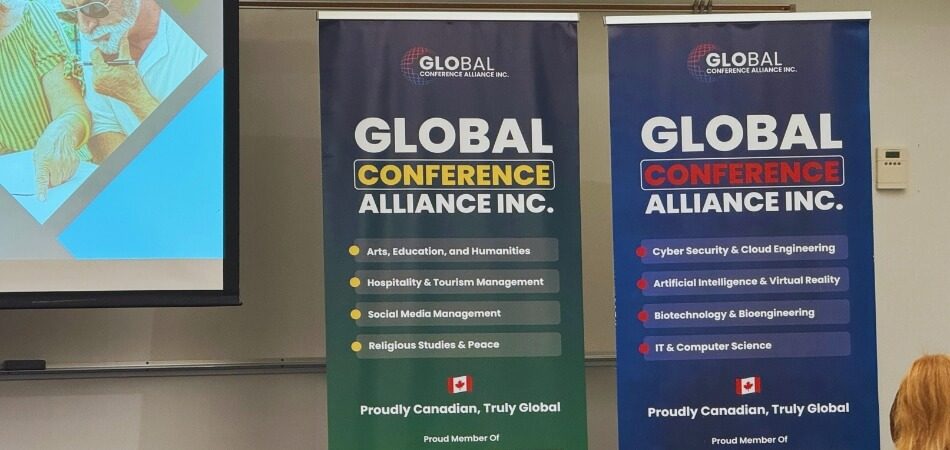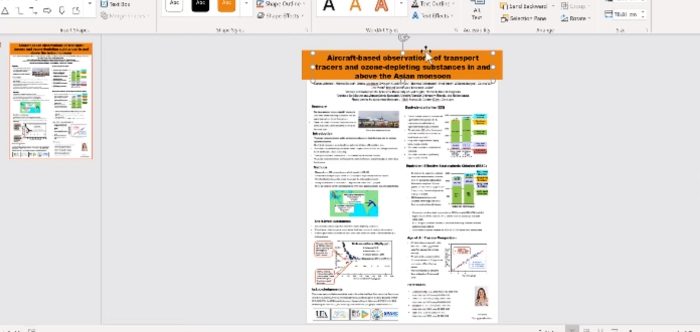When planning a conference, one key aspect often overlooked is the choice of poster finish. This brings us to the question: “Should the conference poster be matte or glossy?”
The matte finishes are ideal for brightly lit or outdoor venues, as they significantly reduce glare, ensuring readability from various angles. On the other hand, glossy finishes are perfect for indoor settings where they can enhance the vibrancy and color depth of the poster, making it stand out.
Both options have their unique advantages, and understanding these can greatly influence the effectiveness of your conference poster. Keep reading to explore deeper into the nuances of each finish and how to make the best choice for your event.
What is a Conference Poster and How Does it Work?
A conference poster is a visual tool used to compactly present research or information at academic or professional gatherings. It typically combines text and graphics to effectively communicate complex ideas in an accessible format. The poster’s design aims to attract and engage viewers, prompting discussions and networking.

In a conference setting, these posters are displayed in a common area, inviting attendees to view them during breaks or designated sessions. They serve as a focal point for presenters to discuss their work with interested parties, facilitating knowledge exchange. This interactive aspect of conference posters makes them a dynamic alternative to traditional presentations.
Well-designed conference posters strike a balance between information and visual allure, meeting the expectations of successful conference organizers. They should be both clear and succinct, considering they are often seen from afar or in passing. Whether opting for a matte or glossy finish, it’s crucial to consider how it will affect visibility and readability in various lighting conditions and settings at the conference venue.
How Visual Appeal Impacts Poster Effectiveness?
Visual appeal plays a pivotal role in the effectiveness of posters, especially in settings where they need to quickly capture attention. A well-designed conference poster can significantly enhance viewer engagement and message retention. Here, we explore how visual elements contribute to a poster’s impact.
- Color choice sets the mood and tone of a poster, influencing viewer emotions and receptiveness to the message. Harmonious color schemes can make complex information more approachable and understandable.
- Typography is crucial; it’s not just about legibility but also about conveying the right feeling and importance. Different fonts and sizes can guide the viewer’s attention to key areas of the poster.
- Imagery, including photographs and illustrations, can tell a story more effectively than text alone. Relevant and high-quality images create a connection and enhance the viewer’s understanding and interest.
- Layout and spacing play a vital role in guiding the viewer’s eye through the content. A well-organized poster allows for easier absorption of information without overwhelming the viewer.
- Consistency in design elements like color, font, and style creates a cohesive and professional appearance. This consistency aids in reinforcing the poster’s theme and message.
- Contrast, whether in color, size, or style, can be used to highlight important information. Effective use of contrast ensures that key points stand out and are easily noticed.
The visual appeal of a poster is not just about aesthetics; it’s a strategic tool to enhance communication and engagement. Thoughtful design choices can turn a simple poster into a powerful medium for information dissemination and audience connection.
Should the Conference Poster Be Matte or Glossy?
Deciding on the finish of a conference poster can greatly influence its overall impact and effectiveness. The choice between a matte or glossy finish hinges on several key factors, each playing a role in how the poster communicates its message. It’s not just a matter of aesthetic preference but also about functionality and context.

Lighting Conditions
Glossy finishes reflect more light, which can cause glare in brightly lit or outdoor settings. Matte surfaces, conversely, absorb light, reducing glare and improving visibility. This makes matte finishes a better choice for areas with intense lighting. However, in dimly lit rooms, glossy posters can appear more vibrant and attractive.
Audience Engagement
Matte posters offer a softer, more professional look that is easy on the eyes. This can encourage longer viewing times, essential for detailed or complex content. Glossy finishes, on the other hand, are more striking and can attract attention from afar. Yet, their reflective nature might be distracting up close, impacting the viewer’s engagement.
Color and Image Quality
Glossy finishes enhance the sharpness and color saturation of images, making them pop. This is ideal for posters with high-resolution photographs or vibrant graphics. Matte finishes provide a more natural and subtle color representation, which can be preferable for text-heavy designs. They are less prone to fingerprint marks, maintaining a clean appearance over time.
Durability and Longevity
Glossy posters are more prone to showing fingerprints and smudges, which can detract from their appearance. Matte posters, while less susceptible to smudging, can be more vulnerable to damage from handling. In terms of longevity, glossy finishes tend to resist fading longer than matte finishes. This makes them a suitable option for posters intended for long-term display.
Printing and Material Costs
The cost difference between matte and glossy finishes can be a consideration for budget-conscious planners. Generally, glossy paper is more expensive than matte due to its additional coating process. However, this cost difference can vary depending on the printer and material quality. It’s important to weigh the cost against the desired outcome and audience impact.
Context of Presentation
The subject matter and context of the conference should influence the poster’s finish. For academic or professional conferences, a matte finish might be more appropriate due to its understated elegance. In contrast, for more dynamic or creative fields, a glossy finish can convey a sense of energy and innovation.
Whether a conference poster should be matte or glossy depends on a combination of factors. These include lighting conditions, audience engagement, color and image quality, durability, cost, and the presentation context. Each aspect plays a part in ensuring that the poster effectively communicates its message and resonates with its intended audience.
Pros and Cons of Matte Conference Poster
Selecting a matte finish for a conference poster comes with a unique set of advantages and drawbacks. It’s a choice that can greatly influence the poster’s effectiveness and the audience’s engagement. Let’s explore the pros and cons of using a matte finish for conference posters.
Pros
- Reduces glare significantly, making it ideal for reading in environments with bright lighting or direct sunlight, enhancing visibility.
- Provides a classic, professional aesthetic that suits academic and formal presentations, offering a subtle yet sophisticated appeal.
- Resistant to fingerprints and smudges, which helps in maintaining a clean and unblemished appearance during prolonged display and handling.
- Enhances readability for text-heavy posters, making it easier on the eyes and ideal for conveying detailed information without strain.
- Absorbs light instead of reflecting it, reducing eye strain for viewers and making it comfortable for longer viewing periods.
Cons
- Colors may appear more subdued compared to glossy finishes, which could reduce the visual impact and vibrancy of the poster.
- Can give off a less contemporary or striking appearance than glossy options, potentially impacting the poster’s ability to catch the eye.
- May not showcase high-resolution images or detailed graphics as effectively as a glossy finish, potentially undermining visual appeal.
While a matte finish offers practical advantages like reduced glare and enhanced readability, it may not be as visually striking as its glossy counterpart. The choice between matte and glossy should consider the content, setting, and desired impact of the poster, balancing practicality with aesthetic appeal.
Pros and Cons of Glossy Conference Poster
Choosing the right finish for a conference poster can greatly impact its effectiveness. A glossy finish, often favored for its visual appeal, offers distinct advantages and some drawbacks. Understanding these can help in making an informed decision for your conference needs.
Pros
- Enhances color vibrancy, making images and graphics stand out with a more dynamic and visually appealing look.
- Offers a professional and sleek appearance, adding a modern and sophisticated touch to the overall aesthetic of the poster.
- Resistant to moisture, which helps protect the poster from humidity-related damage, ideal for varying environmental conditions.
- Can make high-resolution images appear sharper and more detailed, providing a crisp and clear presentation of visual data.
- Reflective surface attracts immediate attention, making it ideal for high-impact presentations and engaging more viewers.
Cons
- Prone to glare under bright lighting, which can hinder readability and viewer engagement, especially in well-lit venues.
- Susceptible to fingerprints and smudges, requiring careful handling and potentially more maintenance to keep it looking clean.
- Typically more expensive than matte finishes, impacting budget considerations, and may not be cost-effective for large-scale printing.
A glossy conference poster can significantly enhance the visual appeal and impact of your presentation, it’s important to consider factors like lighting conditions, handling, and budget. The choice should balance both the content of your poster and the practicalities of the conference venue to ensure your message is delivered effectively and efficiently.
Tips for Designing an Effective Matte Conference Poster
Designing an effective matte conference poster requires a blend of creativity and strategy. Matte finishes offer a unique canvas for conveying information in a visually appealing yet easily readable format. Focusing on key design elements can maximize the impact of your poster.
Color Scheme Selection
- Choose colors that complement each other and enhance readability. Soft, muted tones work well on matte surfaces.
- Avoid overly bright colors that might appear overwhelming. Subtle hues can effectively convey sophistication and clarity.
- Use color contrasts to highlight key areas, ensuring important information stands out without straining the eyes.
Typography and Readability
- Select fonts that are easy to read from a distance. Sans-serif fonts like Arial or Helvetica are often ideal.
- Use different font sizes to create a hierarchy of information, making it easier for viewers to follow the flow.
- Keep the text concise and to the point. Overcrowding with text can make the poster look cluttered and uninviting.
Image and Graphic Usage
- Use high-quality images and graphics that are relevant to your content. Ensure they are clear and not pixelated.
- Matte finishes reduce glare, making detailed images more visible. Take advantage of this by including informative graphs or charts.
- Balance images with text. Too many visuals can distract, while too few might make the poster look barren.
Layout and Organization
- Organize content logically, usually from top to bottom or left to right. This guides the viewer naturally through the poster.
- Provide ample space between different elements. Cluttered posters can be overwhelming and difficult to decipher.
- Consider using boxes or borders to separate different sections, making the poster more structured and easier to navigate.
Final Touches and Proofreading
- Ensure all information is accurate and up-to-date. Fact-checking is crucial for maintaining credibility.
- Proofread for spelling and grammatical errors. These mistakes can detract from the poster’s professionalism.
- Have others review your poster. Fresh eyes can catch errors and provide feedback on design effectiveness.
Creating an effective matte conference poster involves thoughtful consideration of color, typography, imagery, layout, and accuracy. By focusing on these elements, you can develop a poster that not only conveys your message clearly but also stands out in a sea of glossy finishes. Remember, a well-designed poster can be a powerful tool for communication and engagement in any academic or professional setting.
Tips for Designing an Effective Glossy Conference Poster
Designing an effective glossy conference poster requires a blend of artistic flair and strategic planning. The glossy finish brings unique challenges and opportunities, emphasizing the need for thoughtful design. Here are key tips to ensure your glossy poster stands out for all the right reasons.

Utilize High-Resolution Images
- Glossy finishes amplify details, making high-resolution images essential for a sharp and professional look.
- Ensure photos and graphics are of the highest quality to avoid pixelation, which is more noticeable on glossy paper.
- Choose images that complement your content, as the glossy finish will make them more prominent and eye-catching.
Balance Color and Contrast
- Vibrant colors look exceptionally vivid on glossy paper, so use a palette that enhances your poster’s visual appeal.
- Be mindful of color contrast; too much can be overwhelming, while too little may appear dull.
- Use contrasting colors to highlight key information, making it stand out against the glossy background.
Mindful Typography Choices
- Select fonts that are easy to read from a distance, as glossiness can affect text legibility.
- Avoid overly decorative fonts; simplicity and clarity are crucial on a glossy surface.
- Use different font sizes strategically to create a visual hierarchy, guiding the viewer’s eye through the poster.
Manage Glare and Reflection
- Anticipate how lighting will interact with your poster; place important information in areas less prone to glare.
- In venues with strong lighting, orient the poster to minimize reflections that could obscure content.
- Use a matte finish for text-heavy areas if possible, combining it with glossy elements for a balanced effect.
Careful Layout and Spacing
- A well-organized layout is key; ensure there’s enough white space to prevent a cluttered appearance.
- Arrange elements in a way that naturally flows, considering the glossy finish’s impact on the viewer’s gaze.
- Group related content together, using spacing and design elements to clearly distinguish different sections.
In crafting your glossy conference poster, remember that a well-thought-out design is as important as the content it presents. Your aim should be to create a visually appealing, informative, and easily navigable poster. By following these tips, you can effectively harness the strengths of a glossy finish to make a lasting impression.
Bottom Line
In wrapping up, the choice between a matte or glossy finish for a conference poster hinges on various factors, each influencing the poster’s overall effectiveness. The right selection ensures that your poster not only communicates the intended message but also engages the audience effectively.
Centering on the query, “Should the conference poster be matte or glossy?” it’s clear that this decision is more than just a matter of aesthetics. It’s about understanding the environment in which the poster will be displayed and the type of content it will feature. A matte finish excels in bright settings and text-heavy posters, whereas a glossy finish brings out vibrant colors and details in dimmer, more controlled lighting conditions.
The decision should align with your specific needs and the context of your presentation. Whether you choose matte for its classic elegance and readability or glossy for its vibrant and eye-catching qualities, the key is to tailor your choice to both your content and the setting of your conference. This thoughtful consideration will ensure your poster stands out and effectively communicates your research or message.





